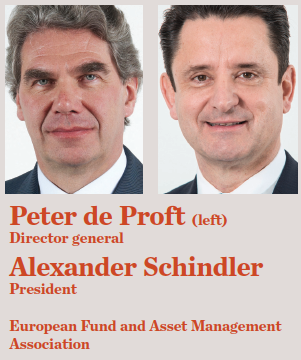The Action Plan for a Capital Markets Union (CMU), recently published by the European Commission, is both ambitious and sensible in the steps it outlines for the realisation of a deeper and more effective single market and fewer cross-border barriers.
It is also, we believe, a significant opportunity to come to grips with the remaining, and considerable, obstacles to achieving a truly unified capital market in Europe. These barriers include the gold-plating of EU legislation by member states, overlapping regulatory requirements and the fragmentation of Europe’s market for personal pensions.
We welcome the action plan, whose aspirations chime with our own in that it aims to promote the financing of the European economy through a well-functioning CMU. Furthermore, the Commission’s intention to assess the impact of previous regulatory changes in this area is surely highly welcome – proper implementation followed by careful evaluation is the key to successful completion of a single capital market.
One outcome of this evaluation will, we hope, be to highlight the overlapping regulatory requirements that are either inconsistent or that conspire, inadvertently, against the creation of a level playing field.
In parallel with this, gold-plating of EU legislation has the effect of imposing legal and regulatory barriers that frustrate the objective of a single capital market in Europe, and we welcome the Commission’s intention of raising this issue with member states. While the European passport system, certainly for UCITS, has clearly demonstrated its benefits and works fairly well, asset managers support the Commission’s stated aim to make the European passport system function better for the cross-border operation of all investment funds.
We are also enthusiastic supporters of the idea of a truly unified European market for personal pensions. The creation of a Pan-European Personal Pension (PEPP) would widen the opportunity for European citizens to make provision for their retirement via long-term investments that will facilitate better outcomes both for savers and the wider European economy.
The PEPP would strengthen the three-pillar pension system in place in Europe, and diversify the risks inherent to the three pillars. Along with occupational pensions, personal pension savings can help reduce the pension gap and contribute to the objective of achieving an adequate and sustainable retirement income for EU citizens in the future.

Importantly, the goal should not be to harmonise all types of existing personal pension products. It should be to create a simple, highly standardised, cost-effective and trustworthy product that can be offered across Europe, thanks to an EU passport.
Achieving a highly standardised product is crucial to avoid gold-plating by member states that would put the overarching goal of the project at stake. This is a necessary condition for the single market for PEPPs to work properly.
Drawing on the experience of asset managers, we consider it important that the PEPP provides choice between investment options with different risk profiles and horizons. We agree that the problem of choice can be addressed by specifying a default option for individuals who are unable or unwilling to make investment choice. And we strongly support the use of a lifecycle strategy, with de-risking, as the default investment option of a PEPP.
Since taxation is one of the barriers to the cross-border activity of personal pension providers, EFAMA believes this could be addressed by considering a single tax regime for PEPPs.
We believe that a common taxed, exempt, exempt (TEE) tax regime for PEPPs could facilitate both the cross-border activity of PEPP providers and the portability of the PEPP for mobile consumers. It is also our understanding that a TEE PEPP is more likely to get the support from national governments, as payments are made from taxed income and governments would not be affected if people change their member state of residence as they would in an exempt, exempt, taxed (EET) regime.
Finally, EFAMA considers that the PEPP should be seen as an integral part of the European Commission’s goal of building a CMU.
The PEPP has the potential to boost the flow of retail savings into capital markets and, therefore, the provision of long-term stable funding to the EU economy. At 42%, today’s proportion of (euro-zone) household financial wealth held in bank accounts is far from optimal. A more diversified allocation of savings would also increase the likelihood of obtaining higher returns, especially considering the long-term investment horizon of retirement savings.
We are therefore committed to remaining proactive in these discussions, and to keep working along with the European institutions and find a way to make the PEPP’s proposal a reality.
Underlying all moves towards a coherent regulatory framework for investment products are the twin issues of trust and consumer protection. We are pleased to see that the Commission agrees with the industry’s own position that regulatory consistency is key to dealing with both these issues. With a level playing field and a single set of regulatory requirements for any type of investment product, be they financial products under the MiFID II (Markets in Financial Instruments Directive) or insurance products with an investment component under the IDD (Insurance Distribution Directive), investors will be able to compare products across the single market and make informed decisions based on transparent information.
This will, in turn, strengthen investors’ trust and confidence. There can be no case for the present co-existence of different levels of consumer protection in what has become a cluttered regulatory landscape. Far from bolstering trust and confidence, they make it difficult, if not impossible, for investors to make fair and meaningful comparisons of similar investment products.
More worrying still is the proposed financial transaction tax (FTT), which will have the effect of fragmenting rather than unifying the European investment market, creating a new barrier between countries that wish to levy the FTT and those that do not. The FTT proposal is inconsistent with a CMU and we urge the Commission to address this.
A CMU is vital not merely for the investment and fund management industry, but for the European economy as a whole. The priority given in the action plan to European Long-Term Investment Funds (ELTIFs) demonstrates the importance of channelling the savings of European investors into longer-term infrastructure projects, thereby stimulating employment and economic growth.
The success of this new type of fund vehicle will depend on a flexible regulatory approach. This is why we welcome the Commission’s encouragement of fiscal incentives at the national level and its proposal to recalibrate the requirements of Solvency II to make it easier for insurers to invest in ELTIF shares and units, given they would be the natural providers of such funds.
The action plan is a welcome statement of intent with regard to the achievement of a CMU. We look forward to seeing it implemented in such a way as to bring down the remaining barriers to a unified market for investment products.


















No comments yet